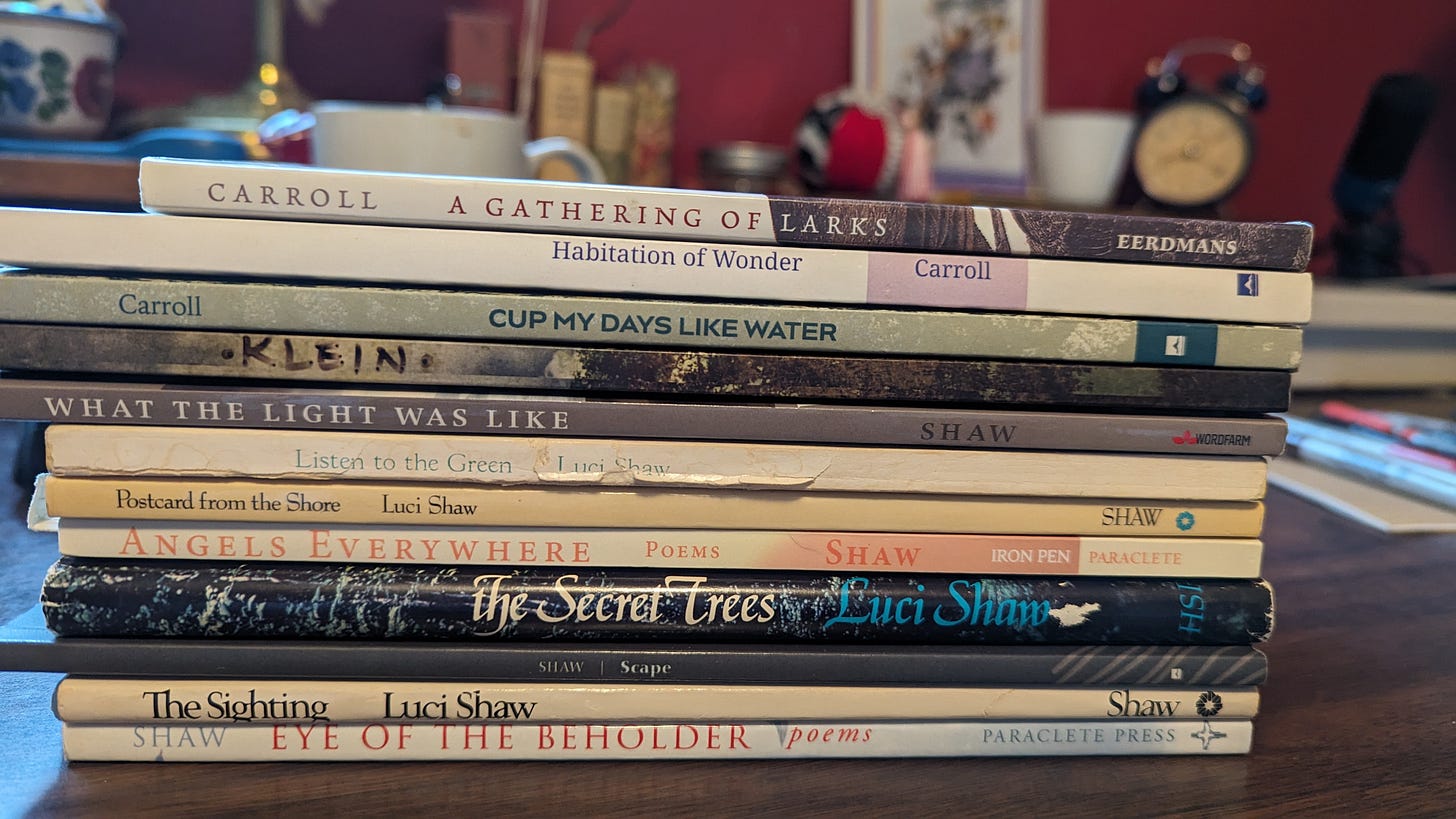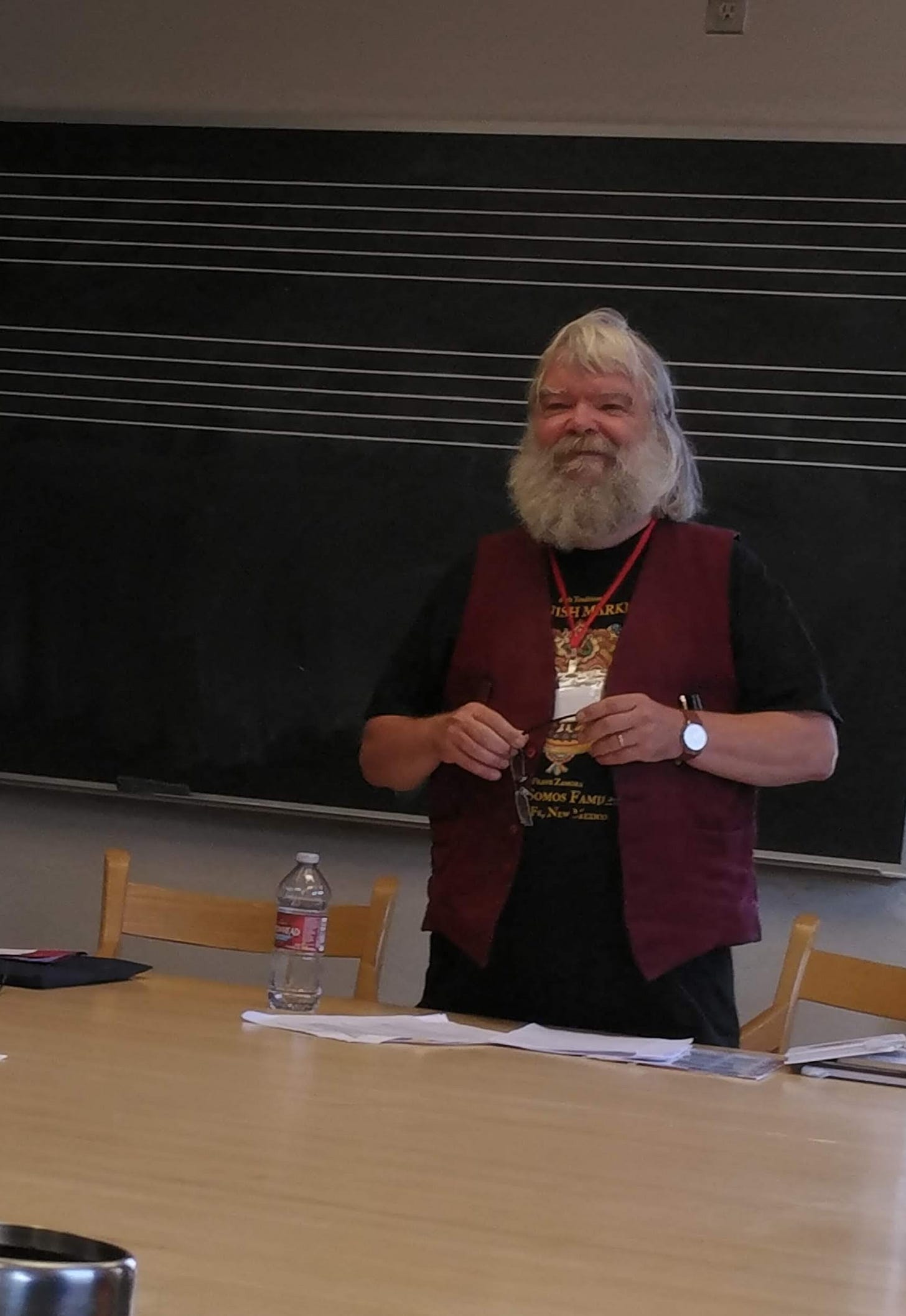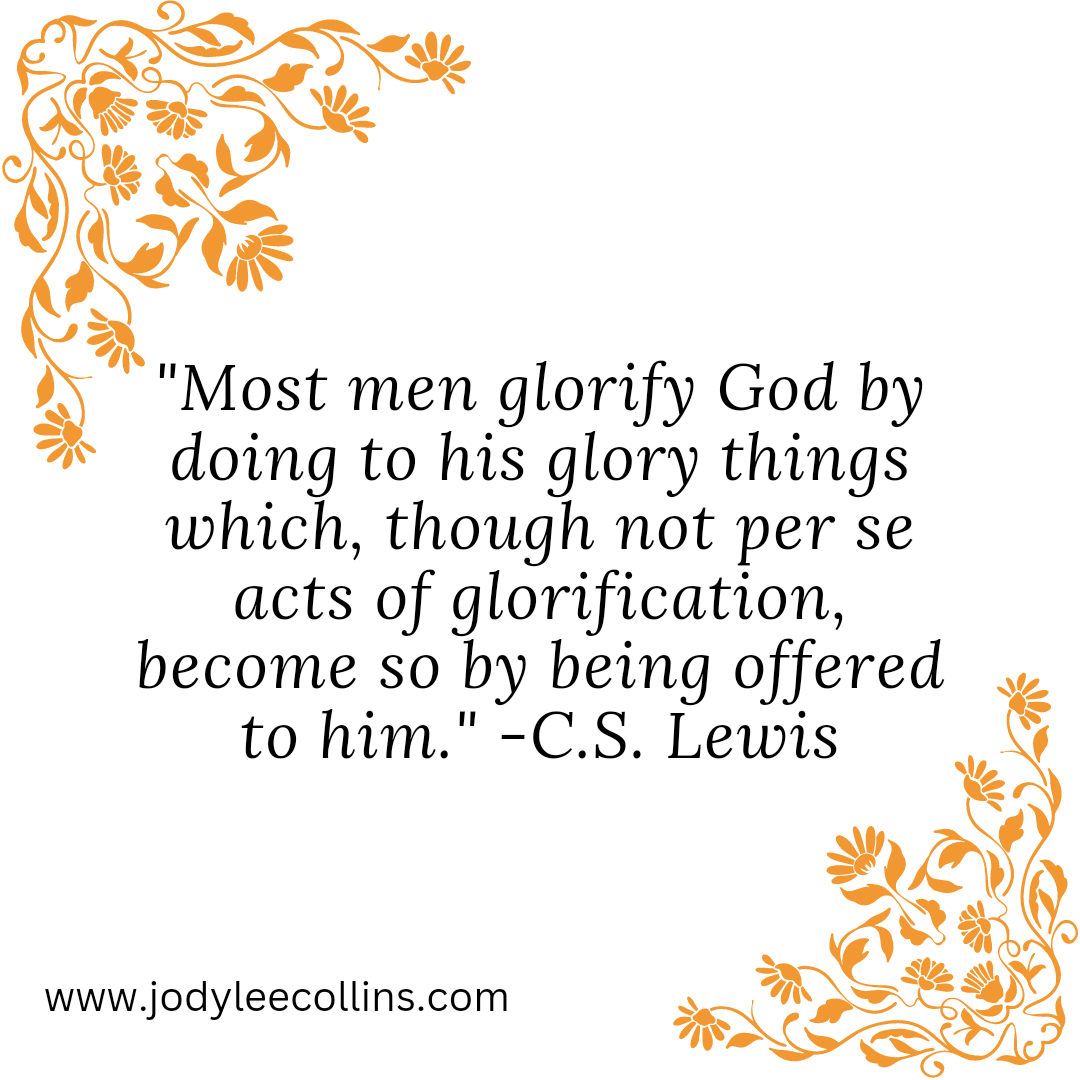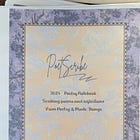3 Reasons to Read Poetry if You're Writing It
Plus a list of poets to get you started + a free resource

It is a truth universally acknowledged that a good writer will also be a wide reader. My own work has been greatly informed and influenced by reading the words of many other Christian poets over the last several years, both contemporary and classical. This active pursuit of poetic learning began in earnest in 2016 when I started attending workshops, panels, conferences and readings, hounding introducing myself to poets whose work I admired, often handing them a copy of their most recent book to sign.
Each and every one has been more than gracious to accomodate my interest (fangirling) and enthusiasm, offering kernels of wisdom and teaching me so very much. For don’t we all enjoy sharing what we love with others?
When I first began scribbling my poems, most of what landed on the page was very bad “poetry,” and pretty cringe, but it was a beginning. As I chose to grow and learn, I invested in an informal education--"The School of 3,000 Books,” as poet Barbara Crooker has said. My poetry today is inspired by contemporary Christian poets like Abigail Carroll, Laurie Klein, Scott Cairns, Christian Wiman, Malcolm Guite, Luci Shaw, Laura Reece Hogan and others, along with classical writers like George Herbert and John Donne.
I have an elementary Teaching Credential and a B.A. in Liberal Studies; I was not a writing or English major in college, thus everything I know about writing a good poem I’ve stolen from many other fine people. And of course I mean ‘stolen’ in the best way. Many, many of the poets in the list included here (scroll down to the bottom of the post) have influenced the poems in both of my books-Mining the Bright Birds: Poems of Longing for Home and Hearts on Pilgrimage: Poems & Prayers.1
So here you are, three reasons to read other peoples’ poetry if you’re going to be writing it.
1. Reading other peoples’ poetry offers seeds for new poems of your own.
I heard Malcolm Guite say in a workshop once, “A good poem is both generative and generous.” In other words, not only will the poem offer something in your reading of what’s actually on the page—an image or emotion that resonates deeply, the generous part—but it can also offer a springboard to respond with a poem of your own—the generative part.
When I first read poet/priest Malcolm Guite’s work, I was drawn in not only by the gospel-centered content but also the remarkable sound and cadence of the language. I've tried my hand at writing my own sonnet, Guite’s specialty, and they are hard to write! Malcolm’s encyclopedic brain can bring up hundreds of poems he’s memorized because of their rhyme and rhythm, a motivation to me and evidence as well of the power of rhyme and meter when it comes to recitation.
Of the seven or so Guite books I own, my current favorite is “David’s Crown—Sounding the Psalms,” where he wrote through Coverdale’s Psalms (from the Book of Common Prayer) responding with a sonnet for each one. These were written during the pandemic and Guite wove the last line of each of his sonnets into the first line of the next. A ‘corona’ or crown, if you will, completing a circle or cycle of poems (after John Donne’s form in La Corona, a cycle of seven poems.)
In David’s Crown Guite begins his response to Psalm 30, ‘Exaltabo te, Domine’,
He gives us too, a voice to sing his praises,
This line became a seed for my own short response, which then became the opening poem in my book, Mining the Bright Birds.
He gives us means to write his praises
The breath to carry every thought
To hearts and out again to raise us
Above, mere creatures whom He has wrought.
We alone hold pen and ink,
Brush and pencil paper thin,
No other image bears his likeness
But ours His work to enter in.
A writer here on Substack, Steven Searcy, has a wonderful book of rhyming poetry Below the Brightness (released by Solum Press) which has also been an inspiration to me. The poems are less formal and sonnet-like but filled with beautiful and appealing cadence and meter. (And feature an endorsement from Malcolm Guite.) Here is Searcy’s poem ‘Hush’
Much noise surrounds.
Let words be few.
Sit.Listen.Chew
Then hear the sounds
of trees and birds.
Sit. Breathe. Release.
And taste the peace
too deep for words.
I responded with my own small poem—
A Rhyme of Wonder
Too immense for words and yet we try
Earthly earth,
Cerulean sky
To share the wonders that must be heard.
Take up your pen
Write it down
Let language resound
And resound again.
We must needs tell
Lest the rocks cry out
And offer their shouts
To break the spell.
2. The second reason to be reading poetry if you’re writing it is to learn form, sound, language and vocabulary.
I always have a pencil in my hand when I’m reading, underlining and making notes in the margin as I go, with poetry especially. There are scads of notebooks on my shelf, journals filled with new words I’ve learned (and mean to look up later). New vocabulary alone is one reason to be reading other poets. I’ve discovered some poly-syllabic wonders, words like: marcescent and alterity and mellifluous. The mouth feel and sound alone is a joy and any poet whose work sends me to my dictionary is an immediate friend and inspiration.
Another reason to read with a pencil in my hand is to underline and make note of the forms, particularly sonnets and the meter and cadence of rhyming poems, but also to make note of the way a poet uses line breaks in free verse.
I notice several things:
How does the poem look visually? Are the line endings even-ish and therefore pleasing to my eyes? (This is a personal preference but a strong one.)
Where does the writer place the ‘turn’ in the lines, (which is the meaning of verse, from ‘versa’ meaning to turn) that moves me along to the next line?
And how can I model the poet’s form itself—primarily when it comes to sonnet-writing—to write a poem of my own?2
3. The third reason to read other poets is to find what resonates with you—the images or emotions—and write that way.
When I say ‘write that way’ I don’t mean to mimic them, but model your work after theirs, to say the same things you feel or see in your own, descriptive way.
What images or emotions come to the surface while you’re reading?
What thoughts or feelings resonate, causing you to say, “I totally can see that,” or “that’s exactly how I feel”?
The way a poet offers new metaphors can be an inspiration that informs your own poetry, giving examples of a physical object as a bridge to an abstract idea or feeling (which is the definition of a metaphor). Poets whose work does this strong images with which to identify have taught me how to look at everyday objects as ‘containers’ if you will for images and ideas.
How is my life like a shell? What does a leaf carry in its way down to the grass? How does a bowl hold something? All of those objects can provide new ways of seeing and thinking.
A List of Where to Begin Reading-A Note First
When I mention Christian poets I do not mean necessarily writers of only biblically-centered, gospel-oriented content. No. I mean writers whose work brings glory to God through its ingenuity, creativity and in the way it points people in the direction of our Creator, as C.S. Lewis so brilliantly says.
You will note I have separated these lists with women in one, men in another. Also, names are in alphabetical order, not by decade (or century, in the case of Anne Bradstreet). Why? I am most familiar with the female poets, many of whom are in real life friends-the contemporary ones, I mean. (Although I did meet Madeleine L’Engle once here in Seattle in the 90’s.) I previously published a more indepth, annotated list on Substack in June 2024 if you want more info than simply their names. The link to that is in the footnotes.3 (Where would I recommend you begin and who are my favorites? I shan’t say…but you can email me at heyjode70 (at) yahoo dot com and find out.) The search engine of choice is your friend, dear Reader.
Female Faith poets-Contemporary (C), Classical(Cl) & 20th Century
1. Abigail Carroll- Cont.
2. Anne Bradstreet-Cl (1612—1672)
3. Anne Porter-20th C
4. Anne Ridler-20th C
5. Barbara Crooker-Cont.
6. Christina Rossetti-Cl (1830-1894)
7. Jane Clement Tyson-20th C
8. Laura Reece Hogan-Cont.
9. Laurie Klein-Cont.
10. Luci Shaw-Cont.
11. Madeleine L’Engle-20th C
12. Phillis Wheatley-Cl (1753—1784)
13. Sara Teasdale-20th C (1884—1933)
14. Susan Cowger-Cont.
15. Tania Runyan-Cont.
Faith Poets, the Guys-Contemporary, Classical & 20th Century
1. Benjamin Myers-Cont.
2. Christian Wiman-Cont.
3. George Herbert-Cl
4. Gerard Manley Hopkins-Cl
5. John Donne-Cl
6. Malcolm Guite-Cont.
Richard Wilbur-20th C
Scott Cairns-Cont.
Seamus Heaney-20th C 1939-2013)
Wendell Berry-C
If you want the above lists in an all-in-one fancy downloadable PDF, click the button below.
Some Substack poets to follow:
I have connected with some remarkable poets on Substack in the last year: Sonneteers Thomas McKendry, Mark Rico, A. Christine Myers and the above-mentioned Steven Searcy. Two other astonishingly gifted writers are E. R. Skulmoski - of is & was and Elizabeth-26th Avenue Poet. Their poetry evokes the deepest responses in me through their wordplay and vivid storytelling in verse. If you’re on Substack, find these folks!
Until next time,
Jody
P.S. Educators, experts and readers—please comment or send me an email if I need to make any corrections! Truly. jodyo (at) jodyleecollins.com
Thanks for reading Poetry & Made Things! Consider subscribing or leave a tip to support my work.
HERE’s a link to my Books page to order a copy of either volume.
Copying poems is a remarkable way to learn; starting a Poetry Notebook is a simple way to do this. Print out the poem you like, 3 hole punch it, add it to a binder with a sheet of blank paper to pen your own thoughts/response… or maybe write your own poem! Over a year, you will have a rich collection.
HERE is a great resource above to do just that, something I created for copying and learning poems to inspire you; I call it PoetScribe.








Thanks so much for this great article. A lot of it resonates with me and reminds me of my own poetic journey. This one’s a keeper!
I just came across this post. Thanks for mentioning my book, Jody. I'm so grateful to hear that it's helped inspire new writing for you! Reading more classic and contemporary poetry is definitely a crucial practice for any writer, at any stage - it's great that you're sharing lists of good starting points to help others along the way.